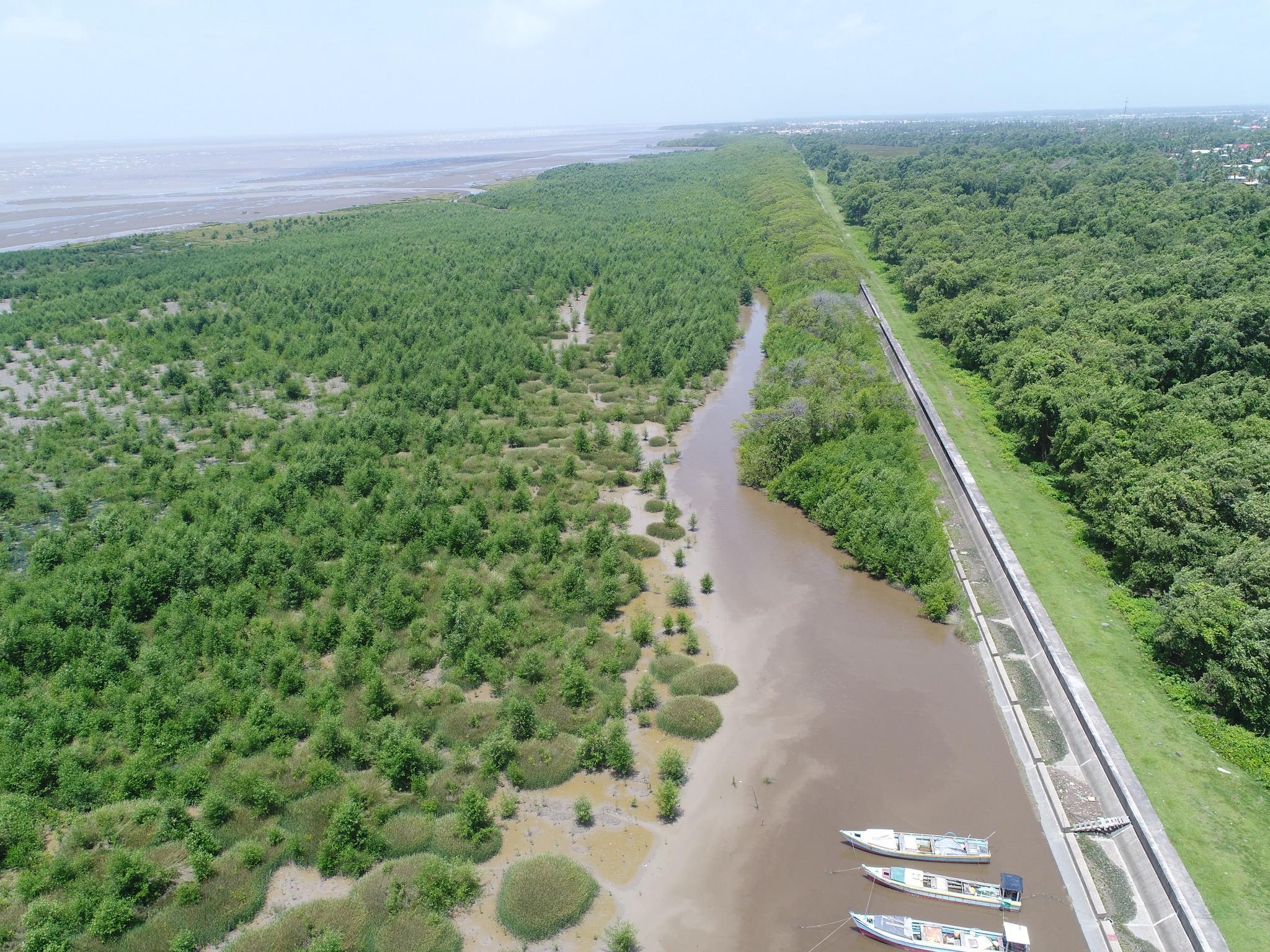Trotting through the swamps of the Imbotero, Barima Waini Mangrove Forest, 50-year-old Huburn Jacobs seeks out crab holes. As he discovers active burrows, he uses grass to block the openings and later returns to retrieve the crabs.
This is a regular routine not just for Jacobs but for many of his Indigenous brothers and sisters from the village. The catches are either used to feed families or sold to earn money.
“We are far away from areas with jobs. We don’t have any jobs in this area, so we depend on the mangrove forest for our survival. It is not just men who catch crabs and fish here but women and children also,” Jacobs explained as he highlighted the importance of the Mangrove Forest to his people.
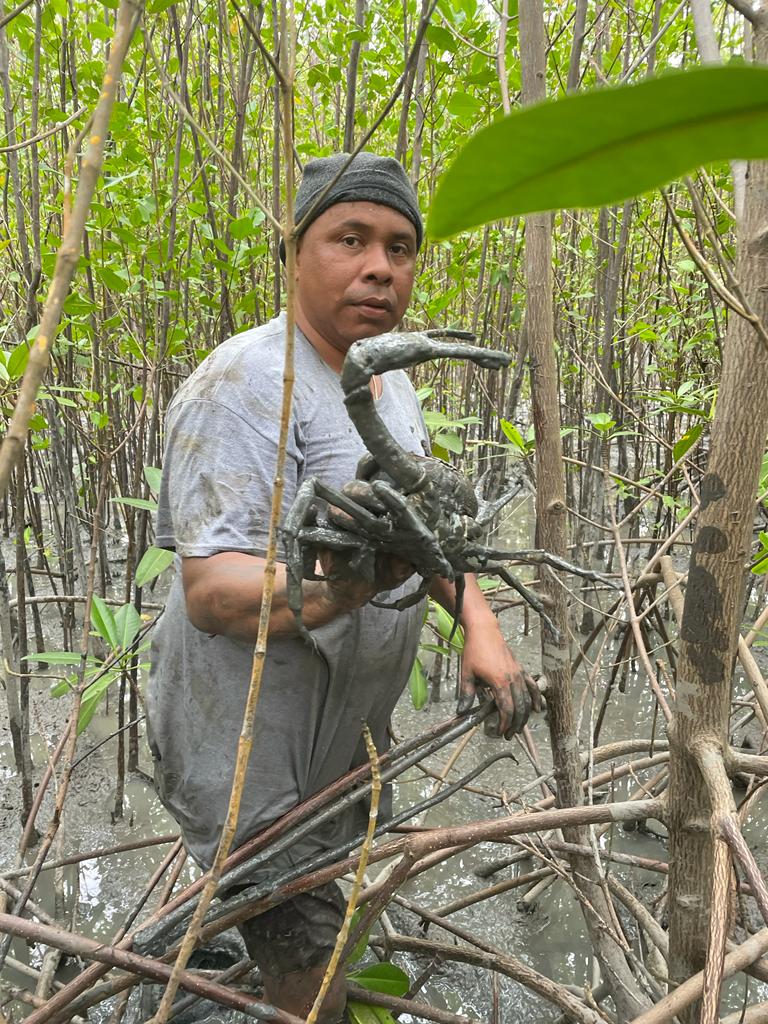
For generations, this ecosystem, located close to the Guyana/Venezuela border, producing mangrove forest fish and crustacean stocks has provided a lifeline to the village.
When there is excess stock, catches are retailed in the township of Mabaruma and even Georgetown, Guyana’s capital.
The Imbotero Mangrove Reserve forms part of the 50,000 hectares of Barima Mora Passage, which has the largest most intact ecosystem and mangrove forest in the country.
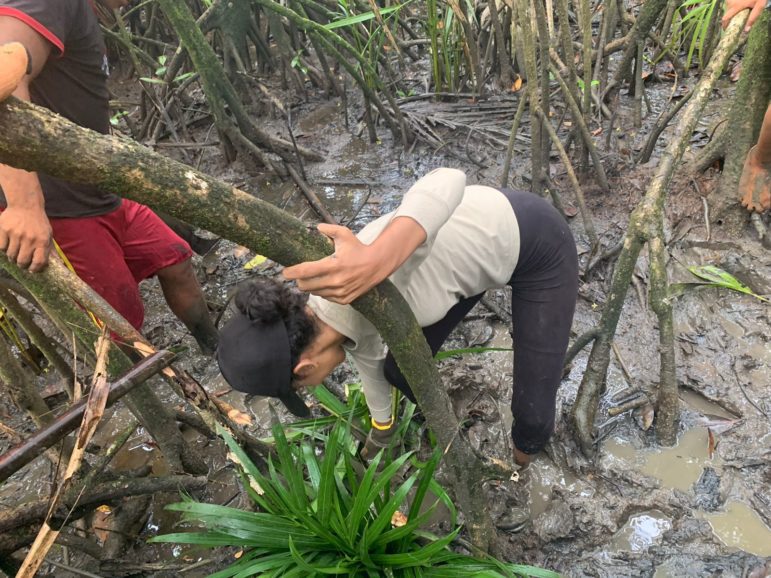
Almost 90% of the country’s population resides along the dynamic 458-kilometre coastline protected by 33,000 hectares of mangroves.
This narrow strip of mainly Black Mangroves, stretching along Guyana’s expansive coast, forms an important guardrail against the ocean. The mangrove forests protect the population against treacherous waves and rising sea levels.
The country’s mangrove ecosystem is described in its United Nations Framework Convention on Climate Change (UNFCCC) National Determined Contributions (NDCs) as a key part of its Emissions Reductions Programme (ERP).
Among other measures, Guyana has said “existing mangrove forests” will be counted as a part of the targets “and the mangrove restoration programme along the vulnerable coast will be expanded.”
Much has however clearly changed since formulation of Guyana’s Low Carbon Development Strategy (LCDS) in 2008. Implementation of the LCDS had been financed primarily with Guyana REDD+ Investment Fund (GRIF) resources earned under the Guyana Norway Agreement (GNA).
Today, the country has emerged as a major source of hydrocarbons globally, with billions of barrels of oil in reserve, and is set to embark on major development programmes based on the sector. It has created apparent anomalies between its longstanding Green Economy objectives.
Last October, ahead of the COP26 in Glasgow, Vice President, Bharat Jagdeo announced a revision of the previous commitment to achieve 100% renewable energy by 2025.
“Everyone around the world has been talking about raising their ambition. But how do we raise from the 100% pledge for which there was no plan or project in place? In fact, this proposal that we have here would be lowering our ambition and we wanted to avoid that,” expressed Dr. Jagdeo.
A new “roadmap on energy” is expected to establish a US$900M gas-to-energy project by 2024-2025 which will cut emissions by 50% with solar and hydro projects increasing the statistic to 70% by the year 2027.
Guyanese climate expert and former Science Advisor to the Caribbean Community Climate Change Centre (CCCCC), based in Belize, Dr Ulric Trotz agrees that “from a moral point and environmental perspective, the best option is to keep the oil in the ground.”
However, he advises that “if we do that as a poor developing country, given the time restriction – the need for accelerated action (on mitigation and adaptation) on our part – where are we going to get the resources from, for that transformation?”
Dr Trotz advised, in a presentation to the Green Institute of the University of Guyana last May that it is important that the wealth generation from exploitation of oil and gas resources be used “to move to zero carbon status.”
He lists as simultaneous priorities the building of resilience in agriculture, the health sector and the continued protection of the country’s low-lying coastal areas.
The implications of all this on communities like Imbotero and others that rely heavily on natural systems, including mangroves, are that there can and will be adverse impacts, at least in the near future.
Hundreds of kilometres away from Imbotero, at Victoria, East Coast Demerara on the populated Atlantic coastline, Carlotta De Jesus and her husband have been using the cool environment of the mangrove forest to operate their apiary.
Operating since 2009, De Jesus told CIJN the couple has been able to produce a unique honey that has created demand more than supply.
The honey from the mangrove apiary at Cove and John holds a distinct flavour, taste, rich colour and quality. “It has this sweet salty taste which can only be because of the mangroves and salty atmosphere from the Atlantic (Ocean),” promotions say.
While her production has scaled down De Jesus still uses the mangrove forest to produce honey to sustain her livelihood.

Conservationist and marine biologist Felicia Collins emphasised mangroves are important to protecting Guyana’s coastline by being a “guard rail” between land and ocean.
She pointed out that during storm surges mangrove forests are most important as they break the force of waves and limit flooding.
“There is also the value of it being a biodiversity hotspot especially for our fisheries sector. Mangroves serve as an important habitat and nurseries for fishes… In addition to that we have seen that the carbon economy is becoming increasingly important in combating climate change,” she said in an interview with CIJN.
With its ability to sequester more carbon than even tropical rainforests, Collins argued that protecting and caring for mangroves now is vital.
“I think in terms of linking it with climate justice, we would come back to that same blue carbon mechanisms where we as a country would realise that we have these mangroves and it is not something that’s found abundantly throughout the world…it is kind of our responsibility to do our part,” Colins argued.
In recent years, the country has witnessed the devastating impacts of the growing absence of such an ecosystem from the coast lines.
Farming communities in Mahaicony account for a high percentage of the country’s rice cultivation but their exposure to overtopping from the Atlantic Ocean between 2018 through 2021 has resulted in extensive crop damage.
Both natural and human actions have contributed to the situation. For example, a rapid erosion cycle on the east coast of Guyana has decimated mudflats and mangrove forests leaving communities vulnerable to flooding. Due to now non-existent forests, there has been catastrophic damage to rice cultivation and poultry and livestock rearing activities.
When the mangrove fringe is washed away just an earthen dam stands between the community farmlands, residences, and the Atlantic Ocean.
During a spring tide in 2018, for instance, the treacherous waves from the Atlantic battered the earthen sea defence that stood as protection, and this resulted in extensive flooding.
Neil Machado, a farmer and community activist, explained that the flooding was something they had never witnessed before and many were caught off guard.
“When the floods came (in 2018) we weren’t able to harvest the rice we had planted. Some farmers tried to salvage their crops but with the fields contaminated with salt water there was little we could have done.”
Over 1,500 acres of rice were threatened, and most was destroyed. The high salinity left behind prevented farmers from returning to the land to cultivate rice to this day.
Most farmers have sought new lands to engage in the trade while some, who were unable to invest, had to seek new jobs to cushion their livelihoods.
“It was not just rice farmers who faced challenges. People were unable to save their poultry because one time the flooding came so quick there was nothing you could have done. Many chickens and some sheep drowned,” Machado related.
Over the years, past and present governments have spent over a billion dollars to construct sea defences to avert major flooding impacts and protect the livelihoods in communities.
Today, the man-made sea defences stand guard for these vulnerable communities and there has been constant monitoring of the coast lines and the activities happening at sea. Sea-level rise resulting from global climate change has dramatic implications for such populations.
By contrast, communities in Berbice, 68 kilometres away from the city and the Essequibo Coast which is 92 kilometres in the opposition direction from the city have witnessed, firsthand, the continuing benefits of mangroves.
Communities in these areas are protected by the lush regrowth of mangroves which now serve as a primary sea defence. Some of these mangroves that now function as the protective barrier against rising sea levels were cultivated under the Guyana Mangrove Restoration Project.
The project, which has been in existence since 2009, with the support of the European Union, has been working within communities across the coast to encourage and promote regrowth activities.
Just a few years ago, a restoration programme was rolled out by the agency in villages in close proximity to Georgetown along the East Coast of Demerara.
But residential communities are not the only ones impacted by the degradation of mangrove forests.
De Jesus explained that her operations have witnessed constant changes in weather patterns and have not been able to produce the type of honey like when they first started production.
“Climate change has really impacted our production and we have seen it firsthand. We are seeing longer dry periods and unusual rainy periods. So, because of this the bees are not able to pollinate the mangrove flowers and they have to go further,” she explained.
She was forced to move a portion of her apiary to higher grounds inland, along the Linden Soesdyke Highway to keep production going.
While she was accustomed to having two to three harvests annually this has changed, and the amount of honey produced has reduced drastically.
Removal of Mangroves
Despite the climate hazards and Guyana’s vulnerability to rising sea levels, and in the face of a transitioning economy into oil and natural gas, the current administration has granted permits to local and international companies to remove swathes of mangrove to pave the way for infrastructural development.
Monetising oil and gas production means better developed waterfront shore base facilities – a requirement that is being treated with urgency. There is huge potential for negative impacts.
Some projects include a wharf for a quarry operator and a base for a deep-water port in Berbice.
Mangroves have been removed by Tri-star Inc; a company operated by Krishna Persaud – an overseas based Guyanese national – to construct a shore base facility at Versailles.
At West Bank Demerara, Nazar ‘Shell’ Mohammed is constructing a wharf facility to serve his quarry business and the oil and gas sector. A Canadian operated CGX energy is also behind a proposed deep-water harbour on the East Bank of the Berbice River.
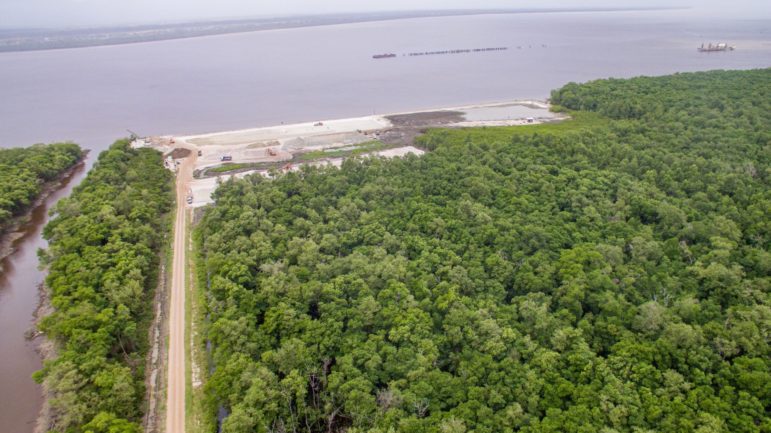
The developers have all claimed that despite removing mangroves, their ventures have a larger beneficial impact via the creation of thousands of jobs to support livelihoods in urban and rural Guyana.
Minister of Public Works, Juan Edghill, under whose portfolio the protection on sea and river falls, has repeatedly said the government will not allow a relatively small portion of mangroves to hinder much needed development.
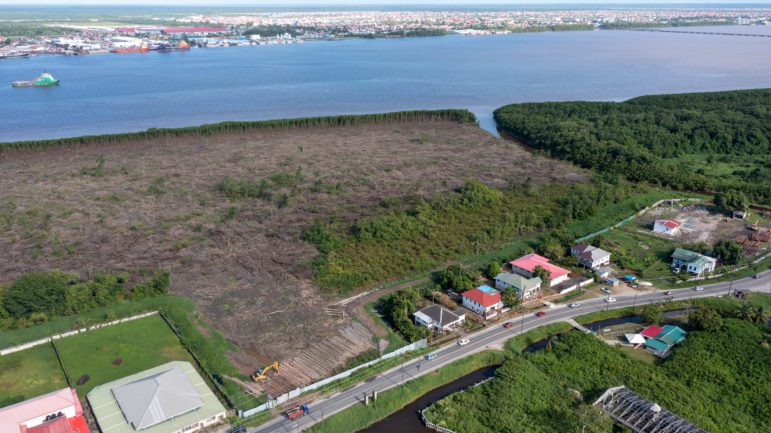
“Let us be very, very, very clear, as a government we are not going to be hamstrung where development of Guyana is concerned. Guyana will be developed in a sustainable way, in a responsible way and while there are some instances we remove a few mangroves, we will replanting more mangroves,” he said in January this year when asked by local media if the government position has changed on the matter.
He was however quick to point out that “we value mangroves, and we will plant more mangroves and where development is taking place where mangroves will be destroyed, we will have to have some compensatory measures to ensure that everything is done sustainably…”

Private companies, faced with a growing backlash from environmental activists and conservationists, have meanwhile been making donations to the country’s restorative and research efforts.
Mitigating Mangrove Removal
To mitigate the impact of mangrove removal, a few companies in the oil and gas sector have contributed financially to the Guyana Mangrove Restoration Project and the Guyana Marine Conservation Society.
In the first half of 2022, oil platform contractor SBM Offshore donated US$312,000 and launched the Annandale/Friendship Mangrove Restoration Project.
The company said the project will see the planting of 20,000 mangrove seedlings. Once mature, the plants will buffer the impacts of vicious waves and protect communities from impacts.
In August 2021, months after Tri Star faced heavily publicised criticism from environmental activists, they made a US$23,000 donation to the Guyana Marine Conservation Society (GMSC) to support research work at Barima Mora Passage mangrove forests. They had removed approximately 48 acres of mangroves for their project.
CGX in their mitigation plan has retained 10 acres of mangrove from the 30-acre plot of allocated for its deep-water project.
At the development site, the company has constructed a riprap (rock armor) sea defence to buffer against strong waves and prevent erosion.
Marine conservationist and activist Annette Arjoon-Martins has called for companies that have been permitted to remove mangroves to be obliged to initiate replanting projects.
“Support the replanting of mangroves in an area six times the size removed and have a stringent monitoring system to ensure at a minimum the survival rate of at least 75%,” she proposes.
There is a view that this going to be much easier said than done, and that the socio-economic impacts of significant disturbance of these valuable ecosystems are liabilities the country will have to live with for a long time to come, even as the climate crisis looms.
This project supported by Open Society Foundations
